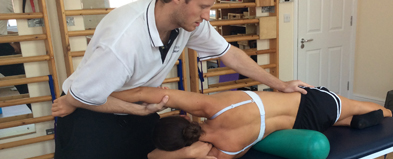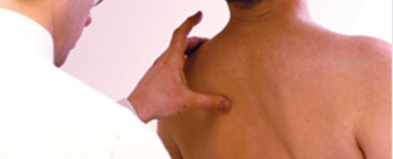Originally, Scoliosis SOS treated patients using the Schroth method alone. However, we soon realised that there were many disadvantages to relying on just one method when treating patients non-surgically – there are elements of postural correction that Schroth is unable to address on its own.
The Schroth method remains a central part of our treatment programmes, but it is now complimented and enhanced by an assortment of other well-established therapeutic techniques from around the world. This ensures that all aspects of each patient’s condition can be properly addressed. The result is what we call the ScolioGold method.
By using our own unique combination of methods, we are able to offer patients an unrivalled level of treatment success that is not available elsewhere. The ScolioGold method is continually monitored and developed to reflect advances in the field of non-surgical treatment, and because of this, our therapy programme continues to deliver gold-standard results.
The principal components of ScolioGold are listed below, with a brief background note about each separate method. For more information or to book your treatment, please get in touch with Scoliosis SOS today.
The ScolioGold Method

Schroth Method
Katharina Schroth (born 1894, Germany) was a physiotherapist who suffered from scoliosis and devised her own treatment method using stretches and mirrors. Following her own success she opened a clinic to treat others. Her daughter, Christa Lehnert-Schroth and grandson, Dr Hans Rudolf Weiss continued Katharina’s work up until 1995, when the clinic was sold to a large corporate organisation.

Rigo-Schroth Method
Rigo-Schroth (est. 1980s, Spain) is a modified version of the original Schroth method, created by Dr Manuel Rigo. While the exercises are still similar, the main difference is the course structure and increased therapist attention for patients.

FITS Method
Functional Independent Treatment for Scoliosis (FITS) (est. 1990s, Poland) takes into account the dysfunctions accompanying scoliosis. Treatment consists of an individually adjusted programme of exercises depending on curvature angle and following clinical examination of the patient. The FITS concept consists of two stages, firstly to eliminate the myofascial restrictions that limit a three-plane corrective movement and secondly to build a series of new corrective posture patterns in everyday activities.
Learn more about the FITS method >
Learn more about the FITS method >

PNF Technique
Proprioceptive Neuromuscular Facilitation (PNF) (est. 1940s/50s, USA) is a physical therapy procedure designed to increase range of motion, flexibility and coordination. Herman Kabat, a neurophysiologist, began to look for natural patterns of movement for rehabilitating the muscles of patients. He believed combinations of movement would be better than the traditional moving of one joint at a time. An institute was later started in Washington, DC to apply his discovery and teach the technique to other therapists.
Learn more about the PNF technique >
Learn more about the PNF technique >

SEAS Method
Scientific Exercise Approach to Scoliosis (SEAS) (est. 1990’s, Italy) is an approach characterised by a specific form of auto-correction (Active Self Correction) taught individually to each patient. This is then integrated alongside stabilisation exercises based on neuro-motor control, proprioceptive training and balance. SEAS is a simple and effective exercise technique that can be applied in any location and with minimal use of external support or equipment.
Learn more about the SEAS method >
Learn more about the SEAS method >

Taping
Kinesio and Traditional Taping (est. 1970’s, Japan) are used as a way of promoting correct muscle movement patterns, reduce pain and inflammation, stimulate or reduce activity of muscles, and provide an elastic reminder for postural control. These are able to be integrated into a patient’s existing rehabilitation programmes. Taping can be used to complement other manual therapies such as myofascial release to give a much longer lasting therapeutic effect.
Learn more about the Taping method >
Learn more about the Taping method >

Myofascial Release
Myofascial Release (est. circa 1940s, USA) is a form of soft tissue therapy used to treat an impaired musculoskeletal system, accompanying pain and restriction of motion. This is accomplished by relaxing contracted muscles, increasing circulation, increasing venous and lymphatic drainage and stimulating the stretch reflex of muscles and overlying fascia. It developed from the findings of a number of medical practitioners including Dr Ida Rolf, Elizabeth Dicke and Andrew Taylor Still (father of osteopathic medicine).
Learn more about the myofascial release method >
Learn more about the myofascial release method >

Osteopathy
Osteopathy (est. 1874, USA) is an approach to healthcare that emphasizes the role of the musculoskeletal system in health and disease. The practice of osteopathy began with the work of Andrew Taylor Still. It has been considered a form of complementary medicine, emphasising a holistic approach and the skilled use of a range of manual and physical interventions in the prevention and treatment of disease. In practice, this most commonly relates to musculoskeletal problems such as back and neck pain. Osteopathic principles teach that treatment of the musculoskeletal system (bones, muscles and joints) facilitates the recuperative powers of the body.
Learn more about osteopathy >
Learn more about osteopathy >

Trigger Point Therapy
Trigger Point Therapy (est. 1930s, USA) was the result of the work of American Physician Janet Travell. Trigger points have been a subject of study by a small number of doctors for several decades, although this has not become part of mainstream medicine. The existence of tender areas in muscles has been recognised in medicine for many years; indeed, studies have shown that around 75% of pain clinic patients have a trigger point as the sole source of their pain. However, the trigger point concept remains unknown to most doctors and is not generally taught in medical school curricula.
Learn more about trigger point therapy >
Learn more about trigger point therapy >

Orthopaedic Medicine
Orthopaedic Medicine (est. 1929, UK) is the examination, diagnosis and treatment of non-surgical lesions of the musculoskeletal system. Dr James Cyriax observed a number of patients where the diagnosis was vague and the treatment non-specific. There appeared to be no satisfactory method for testing the function of soft tissues to achieve a clinical diagnosis. He developed a system of assessment aiming to accurately diagnose lesions of the musculoskeletal system and a non-surgical method of treatment for soft tissue lesions.

Medical Acupuncture
Medical acupuncture combines traditional acupuncture, as practiced for thousands of years in the Far East, and our modern understanding of anatomy, physiology and pathology. It involves the insertion of very fine needles into specific points on the body to help reduce pain by blocking nerve signals, improving blood flow and promoting healing to the affected area. Many people with scoliosis experience musculoskeletal pain due to the muscular imbalances and postural asymmetry that can arise as a result of the spinal curvature. Specialist medical acupuncture can be used to help treat this pain and restore normal movement and function.
Learn more about medical acupuncture therapy >
Learn more about medical acupuncture therapy >

Dry Needling
Dry needling (est. 1940s, USA) was devised by two American doctors Janet Travell and David Simons when they used injections into affected muscles to reduce sensitivity and relieve pain. In 1979, Dr Kavel Lewit concluded that this pain relief was primarily caused by the insertion of the needle itself, rather than the medication being injected. Since then, dry needling has been used as an effective means of treating knots (also known as trigger points) in the muscles of the human body.
Learn more about dry needling therapy >
Learn more about dry needling therapy >

SIJ
The Sacroiliac Joint (SIJ), joins the spine to the pelvis and is made up of the sacrum and the right and left ilium. Pain located over the Sacroiliac Joint is often reported in people with scoliosis. A spinal curvature is likely to impact on the alignment of the sacroiliac joint, which in turn results in pain and movement dysfunction in this area. It is therefore important to assess and monitor for any pelvic dysfunction that may be present in people with scoliosis, so that appropriate manual therapy techniques can be provided to restore optimal alignment and movement to this area.
Learn more about SIJ therapy >
Learn more about SIJ therapy >

Hydrotherapy
Hydrotherapy (or Aquatic Therapy, as it is now more commonly known) is derived from two Greek words “Hydor” (water) and “Therapeia” (healing). It dates back as far as ancient Egyptian, Greek and Roman times, when it was used as a form of therapeutic relaxation. Hydrotherapy was first officially used as a medical treatment by Vincent Priessnitz in 1829. At Scoliosis SOS our physiotherapy team use a programme of Aquatic Therapy to harness the properties of water to maximise physical, physiological and psychosocial function. It provides excellent core stability training to help build the trunk musculature and control the position of the spine, as well as aid and promote faster recovery times.
View upcoming ScolioGold course dates here.
My Patient
ExperienceMeet The Team
ExperienceMeet The Team
"
Sally (mother of 15-year-old James) from Norfolk
To everyone at Scoliosis SOS - Many thanks for all your hard work and patience. You are a wonderful team making a real difference to people's lives.
"